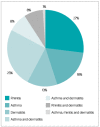Occupational allergic disease: socio-epidemiological aspects from a specialized outpatient clinic in the city of Sao Paulo, Brazil
- PMID: 32377584
- PMCID: PMC7200143
- DOI: 10.5327/Z1679443520170095
Occupational allergic disease: socio-epidemiological aspects from a specialized outpatient clinic in the city of Sao Paulo, Brazil
Abstract
Background: Occupational diseases involving the immune system are considered to be occupational allergic diseases (OAD); 15% of occupational diseases are allergic. The social consequences of OAD are significant for both workers and employers.
Objectives: To describe demographic and clinical characteristics of patients with OAD and their social outcomes.
Methods: Descriptive and retrospective study of the medical records of patients diagnosed with OAD cared at the occupational allergy clinic of a university hospital in São Paulo, Brazil.
Results: A total of 72 patients exhibited OAD, with age 21 to 89 years old; 52% were male. Atopic antecedents were described for 35% of patients. Most patients worked in the chemical industry (17%), cleaning (15%), construction (11%) and health care (8%). Occupational rhinitis was found in 26% of the patients, work-related asthma in 18%, asthma and rhinitis in 25%, and allergic contact dermatitis in 13%. In regard to the social outcomes, 36 (50%) workers remained in their jobs, 19 (26%) changed function, 7 (10%) changed occupation, 7 (10%) were fired and 3 (4%) retired.
Conclusions: In the present study, OAD prevailed among males and within the economically active age; cases of occupational rhinitis were the most frequent. Half of the employees remained in the same job position even after diagnosis.
Introdução: Doença ocupacional envolvendo o sistema imunológico é considerada doença alérgica ocupacional (DAO). Das doenças ocupacionais, 15% são alérgicas. As consequências sociais do diagnóstico de DAO são importantes para o trabalhador e empregador.
Objetivos: Descrever características demográficas e clínicas dos pacientes estudados com DAO e seus desfechos sociais.
Métodos: Estudo descritivo, retrospectivo dos prontuários de pacientes do ambulatório de alergia ocupacional de hospital universitário em São Paulo, com diagnóstico de DAO.
Resultados: 72 pacientes apresentaram DAO, com idades entre 21 e 89 anos; 52% do sexo masculino. Antecedentes atópicos foram descritos em 35% dos pacientes. A maioria dos pacientes trabalhava nas áreas de indústria química (17%), limpeza (15%), construção civil (11%) e saúde (8%). Rinite ocupacional foi vista em 26% dos pacientes; asma relacionada ao trabalho, em 18%; asma e rinite, em 25%; dermatite de contato alérgica, em 13%. Sobre o desfecho social, 36 (50%) mantiveram-se em seus cargos, 19 (26%) mudaram de função, 7 (10%) mudaram de área, 7 (10%) foram afastados e 3 (4%) se aposentaram.
Conclusões: Na casuística estudada, a DAO prevaleceu no sexo masculino, em faixa etária condizente com faixa trabalhadora; com maior número de casos de rinite ocupacional. Metade dos pacientes continuou exercendo a mesma função mesmo após o diagnóstico.
Keywords: allergy and immunology; asthma, occupational; dermatitis, occupational; rhinitis, allergic.
Figures



Similar articles
-
Rhinitis and asthma symptoms in non-domestic cleaners from the Sao Paulo metropolitan area, Brazil.Occup Environ Med. 2007 Jul;64(7):446-53. doi: 10.1136/oem.2006.032094. Epub 2007 Feb 15. Occup Environ Med. 2007. PMID: 17303675 Free PMC article.
-
Occupational chromate allergy in Singapore: a study of 87 patients and a review from 1983 to 1995.Am J Contact Dermat. 1998 Mar;9(1):1-5. Am J Contact Dermat. 1998. PMID: 9471980
-
Prevalence of atopic dermatitis, asthma, allergic rhinitis, and hand and contact dermatitis in adolescents. The Odense Adolescence Cohort Study on Atopic Diseases and Dermatitis.Br J Dermatol. 2001 Mar;144(3):523-32. doi: 10.1046/j.1365-2133.2001.04078.x. Br J Dermatol. 2001. PMID: 11260009
-
Precision medicine in patients with allergic diseases: Airway diseases and atopic dermatitis-PRACTALL document of the European Academy of Allergy and Clinical Immunology and the American Academy of Allergy, Asthma & Immunology.J Allergy Clin Immunol. 2016 May;137(5):1347-58. doi: 10.1016/j.jaci.2016.03.010. J Allergy Clin Immunol. 2016. PMID: 27155030
-
[Occupational diseases caused by exposure to sensitizing metals].Sangyo Igaku. 1993 Mar;35(2):75-87. doi: 10.1539/joh1959.35.75. Sangyo Igaku. 1993. PMID: 8510347 Review. Japanese.
Cited by
-
Occupational dermatoses in the Brazilian South region recorded in a reporting system (2007 to 2016).Rev Bras Med Trab. 2020 Apr 24;16(4):442-450. doi: 10.5327/Z1679443520180261. eCollection 2018. Rev Bras Med Trab. 2020. PMID: 32754659 Free PMC article.
-
Reports of occupational dermatosis in the state of Espírito Santo from 2007 to 2016.Rev Bras Med Trab. 2021 Apr 30;19(1):60-67. doi: 10.47626/1679-4435-2021-587. Rev Bras Med Trab. 2021. PMID: 33986781 Free PMC article.
References
-
- Araújo TM, Graça CC, Araújo E. Estresse ocupacional e saúde: contribuições do modelo demanda-controle. Ciênc Saúde Coletiva. 2003;8(4):991–1003.
-
- Galvão CES. Asma e rinite ocupacionais: visão imuno-alérgicas. Rev Bras Alerg Imunopatol. 2010;33(1):2–7.
-
- Murofuse NT, Abranches SS, Napoleão AA. Reflexões sobre estresse e Burnout e a relação com a enfermagem. Rev Latino-Am. Enferm. 2005 Apr;13(2):255–261. - PubMed
-
- Royal College of Physicians . Allergy: The Unmet Need. A Blueprint for Better Patient Care. A Report of the Royal College of Physicians Working Party on the Provision of Allergy Services in the UK. 2003.
-
- Peden D, Reed CE. Environmental and occupational allergies. JAllergy Clin Immunol. 2010;125(2) 2:S150–S160. - PubMed
LinkOut - more resources
Full Text Sources
